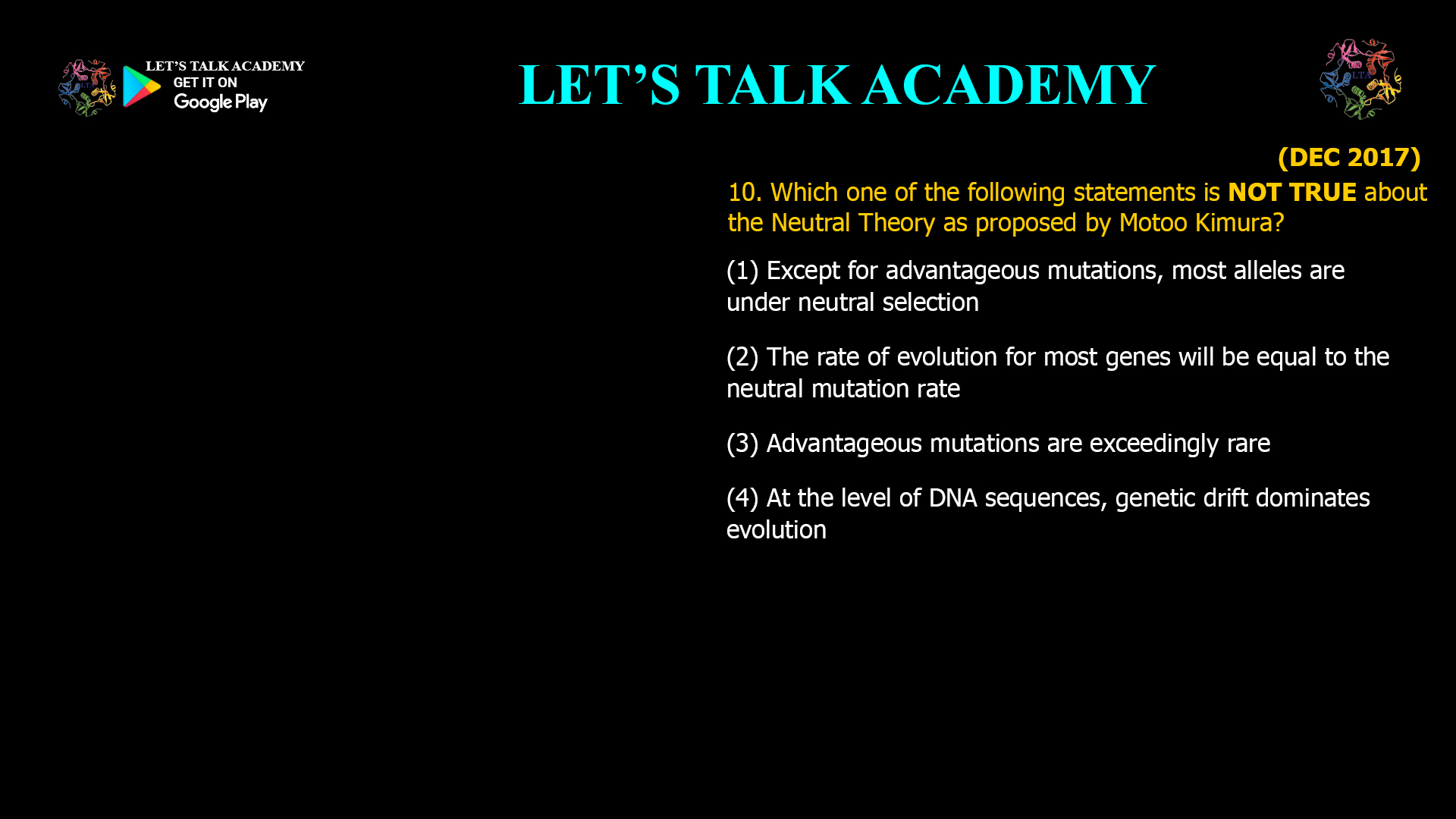- Which one of the following statements is NOT TRUE about the Neutral Theory as proposed by Motoo Kimura?
(1) Except for advantageous mutations, most alleles are under neutral selection
(2) The rate of evolution for most genes will be equal to the neutral mutation rate
(3) Advantageous mutations are exceedingly rare
(4) At the level of DNA sequences, genetic drift dominates evolutionUnderstanding the Neutral Theory of Molecular Evolution: What Is NOT True About Kimura’s Proposal?
The Neutral Theory of Molecular Evolution, proposed by Japanese evolutionary biologist Motoo Kimura in the late 1960s and elaborated in his 1983 monograph, revolutionized how scientists view genetic variation and evolutionary change at the molecular level. It challenged the traditional Darwinian emphasis on natural selection by suggesting that most evolutionary changes in DNA and proteins are the result of random fixation of neutral mutations rather than adaptive selection.
While the theory has been widely influential, some misconceptions about its claims persist. Here, we clarify the core ideas of the Neutral Theory and identify which common statement about it is NOT TRUE.
Core Principles of Kimura’s Neutral Theory
-
Most mutations that become fixed are neutral or nearly neutral:
These mutations do not affect an organism’s fitness and accumulate mainly through genetic drift rather than natural selection. -
Advantageous mutations are exceedingly rare:
Beneficial mutations that increase fitness occur infrequently and thus contribute little to the overall rate of molecular evolution. -
Rate of evolution equals neutral mutation rate:
The substitution rate of neutral mutations is approximately equal to the mutation rate, independent of population size. -
Genetic drift dominates molecular evolution:
At the DNA sequence level, random drift of neutral alleles is the primary driver of evolutionary change.
Evaluating the Statements
Let’s examine the four statements to identify which is incorrect:
-
Except for advantageous mutations, most alleles are under neutral selection
This is true. The Neutral Theory posits that most mutations are neutral, with only a small fraction being advantageous or deleterious. -
The rate of evolution for most genes will be equal to the neutral mutation rate
This is true. Kimura showed that the rate of molecular evolution is governed by the neutral mutation rate, as neutral mutations fix at that rate via drift. -
Advantageous mutations are exceedingly rare
This is true. The theory emphasizes the rarity of beneficial mutations relative to neutral or deleterious ones. -
At the level of DNA sequences, genetic drift dominates evolution
This is true. Genetic drift of neutral mutations is the main mechanism driving molecular evolution according to the theory.
Which Statement Is NOT True?
All four statements reflect key aspects of Kimura’s Neutral Theory. However, the first statement says “most alleles are under neutral selection,” which is a misphrasing. The theory states that most mutations are neutral, not that most alleles are under neutral selection. Selection acts on alleles, but neutral mutations are by definition not subject to selection. The phrase “neutral selection” is contradictory because selection implies differential fitness, while neutrality means no fitness effect.
Thus, statement (1) is NOT true as phrased, because it incorrectly suggests that alleles are under neutral selection, rather than being neutral (i.e., not selected).
Summary of the Correct Understanding
-
Most mutations are neutral and fixed by genetic drift.
-
The molecular evolutionary rate approximates the neutral mutation rate.
-
Beneficial mutations are rare.
-
Genetic drift dominates molecular changes at the sequence level.
Conclusion
Motoo Kimura’s Neutral Theory fundamentally reshaped evolutionary biology by highlighting the role of neutral mutations and genetic drift in molecular evolution. Among common statements about the theory, the idea that “most alleles are under neutral selection” is incorrect because neutrality implies absence of selection.
Correct answer:
(1) Except for advantageous mutations, most alleles are under neutral selection — this statement is NOT TRUE. -



